
i'm now actively seeking out blogs and websites featuring images of abandoned things and places. it's a temporary addiction, maybe i'll get over it. or maybe i'll start a new blog about it, if i find enough changing sources that i could post about. check out the abandoned-places website for a ton of images.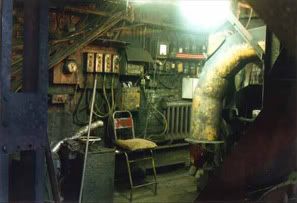


Saturday, May 28, 2005
more abandoned places
Posted by
Jim
at
10:37 PM
5
comments
![]()
11 ways to be super smart
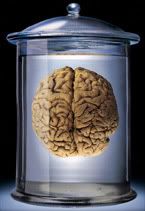
for those bent on world domination: new scientist recently released an overview of 11 ways to improve the functioning of your brain, most of the advice is super easy. one of the highlights was as simple as breakfast in the morning. kids that had sugary fizzy breakfast performed about as well as 70 year old men in tests of memory and attention, and eating breakfast in general improved the functioning of brains throughout the day. best things to eat include toast and eggs. beans were also suggested, but who eats beans for breakfast?
exercise is definitely necesario. just walking for a half hour 3 times a week improved learning, concentration and abstract reasoning by 15 percent. even more interesting, cleveland clinic foundation in ohio did an experiment where people were asked to merely think about exercising their arm muscles for 15 minutes a day. after 12 weeks their arm muscles were 13% stronger. mind over matter.
check out the article if you want more cheats to being smarter.
Posted by
Jim
at
10:00 PM
0
comments
![]()
Thursday, May 26, 2005
virtually perfect vanda hybrida orchids

if we recorded every electrical impulse within a living thing, couldn't we theoretically recreate a nearly perfect version inside of a computer, allowing the living thing to regrow virtually for all eternity? it's like that movie where you have to decide whether to download your consciousness in computers and live forever or let yourself die naturally and face your own mortality, except... it's vanda hybrida orchids instead of humans. by recording the electrical signals of the plants the life support systems project has developed a very personal internal history of the way the plants developed and grew. this is then recreated by the life support systems project inside of a hacked xbox video game console, where you can view a "visualization of the language model" or listen to the generated signals presented as sound.
oh! it's also like that william gibson book where they store famous hackers brains inside of small computers, but the hackers still feel consciousness after they're dead because they're trapped in a computer system, but the main character eventually destroys it for them so they can live in peace.
idea via we make money not art
Posted by
Jim
at
8:31 PM
0
comments
![]()
abandoned shopping carts
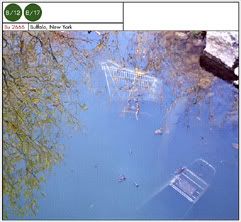
the stray shopping cart has become the ultimate sign of postmodern alienation. seeing capitalism's unwanted detritus filling up creeks, roadsides, and woods, shopping carts remind us of the gleaming aisles of our great halls of repetition, seeing objects over and over walking through the colorful aisles of the supermarket. is it somehow essential that supermarket waste slowly seeps out into the world at large through the medium of abandoned shopping carts? well, for some reason i love looking at abandoned things like these, and if you've noticed my posts lately, spectacular science news can get a bit boring, since it's all quite the same. abandoned fragments of civilization remind us of something we don't usually see in the glossy ads of the fetishized media, that society's garbage tells us more about ourselves than anything else. visit strayshoppingcart.com to see julian montague's enormous image collection of found and categorized shopping carts, lost across america. 


Posted by
Jim
at
7:57 PM
0
comments
![]()
Monday, May 23, 2005
abandoned amusement parks and decaying buildings


for those of you with a fetish for the beauty of abandoned civilization, check out this photo gallery of an old and abandoned amusement park, or visit the rest of this site (in japanese, but navigatable) to see a lot more galleries of abandoned buildings, condos, jails, strange towns, etc.
idea via data is nature
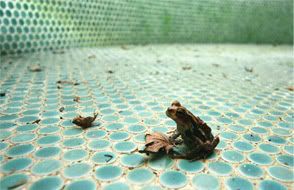

Posted by
Jim
at
8:02 PM
1 comments
![]()
Sunday, May 22, 2005
secret graffiti

josh homme of queens of the stone age is creating a new revolution in hotel vandalism. rock bands have long been known for trashing hotel rooms, but rarely for secretly beautifying them. while his band is on tour, whenever they stop at a hotel they will move certain fixtures out of the way (paintings, mirrors, toilets) and draw secret artwork behind them. homme and other artists are now even beginning to get paid by some hotel chains to do this, hoping that people would pay extra to stay in rooms with celebrity graffiti in them. but this expression isn't merely for celebrities - homme and friends hope that it will catch on in a major way, bringing secret wall tattoos to hotel rooms everywhere.
see all pictures at secretwalltattoos.com
idea via future feeder


Posted by
Jim
at
8:32 PM
0
comments
![]()
life straw to save lives

researchers led by torben vestergaard frandsen in denmark have designed a new straw, called the lifestraw, that may save the lives of people living in areas with unsafe water. the straw acts like an advanced brita filter, processing the drinking water through a chamber of iodine beads which kills viruses, parasites and bacteria, followed by a section of carbon to kill any remaining parasites and filter out the iodine taste. the straw would filter out some of the world's greatest killers, such as typhoid, cholera, e. coli, salmonella, and others. the straw is said to be cost effective for people even in poor countries, and can last for up to a year of use.
Posted by
Jim
at
7:40 PM
0
comments
![]()
Tuesday, May 17, 2005
transportation futuristics

transportation futuristics is an online exhibit of the visions and designs people had when thinking about vehicles of the future.
idea via tacky times
Posted by
Jim
at
9:31 PM
0
comments
![]()
Monday, May 16, 2005
blog-o-matic

On Strangers in my Hometown
Last night I dreamt we simply need to realize to love who we live with. Why am I talking about Strangers in my Hometown, you may ask? So... Sometime around last year I used to sing and dance. Yeah, RIGHT. As I was saying... Although it felt more like a dream to me then. I dreamt of a giant banana. This is special, because...
this blog entry was created by the random blog generator at blog-o-matic. can't think about something to post about? now you can have someone else do it for you, and we both know it would be more interesting than whatever you were going to talk about anyway.
also check out the postmodernism generator, which randomly generates essays on postmodernism from jargon.
Posted by
Jim
at
7:57 PM
0
comments
![]()
blog star theater

i must admit that i have a love-hate relationship with blog culture. the kind of blog i like is creative and informative, but the majority of blogs seem to be about absolutely nothing important. they are teenage diaries ad nausium, filled with drama that only the writer, and perhaps a few close friends, usually cares about. but now someone is beginning to take all of the bland internet fodder and reformat it in a creative way. blog star theater is a blog dedicated to theatrical reproductions of other people's blogs, videotaped and attached to the site weekly. blog star theater takes these tales of small concern, and humorously detournes them into interesting adventures, making something that was once bland - the stories of strangers - and turns it into something interesting and new. anyone is allowed to produce and submit an episode, so if you're interested, i think you can make an episode on your own and send it in.
blog star theater is at http://www.blogstartheater.com/
idea via reg posting on smart mobs
Posted by
Jim
at
7:22 PM
0
comments
![]()
Sunday, May 15, 2005
hunt animals over the internet

live-shot.com is a website that allows you to fire real guns over the internet. they've attached a camera, a computer, and a rifle together so that you can do target practice online, and even get the targets mailed to you. they originally started with meager paper targets, but now they're finally moving up and releasing a new service - real animals! nothing to do on a sunday afternoon? too drunk or paraplegic to go real hunting? well, now you can go online and shoot some animals, without even leaving your home. not only that, but they'll taxonify them for an extra fee, and also mail you the meat if you want. hunts start at $150, but prices add up with extra services.
the rifle is set up on a 300 acre spread in san antonio, stocked with different game.
you can shoot barbary sheep
blackbuck antelope
sheep - "corsican, mouflon, and crosses"
and even wild hog (isn't he somehow dashing?)
bigger article at the boston globe - "live shot is the target of critical fire"
thanks to beverly tang for the idea, who reblogged book of joe
Posted by
Jim
at
3:42 PM
1 comments
![]()
news in reverse: virtual island sold for $26,500

a virtual island in the mmorpg online game project entropia sold for $26,500 in real money last year to david storey, a 22-year old player based in australia. the island rumoredly contained 6,000 acres of land, a castle, a mine, and fantastic beasts to hunt. the lines between virtual worlds and the real world has been blurring for a while now, as players have long used sites like ebay to sell rare items for real cash- commonly for anywhere between $1 - $50. project entropia is a rare mmorpg, because online money is transferrable into real money. the game doesn't have an online fee, but apparently has real money fees to keep certain parts of your game running smoothly. this is then converted into artificial money and injected into the virtual economy, allowing the online money you make in the game to also be transferred back into real cash, since it all started out that way anyway.
full article at new scientist
Posted by
Jim
at
2:31 PM
0
comments
![]()
Saturday, May 14, 2005
everything bad is good for you
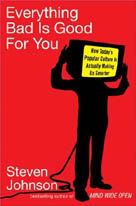
the new yorker reviews steven johnson's book: everything bad is good for you.
johnson proposes something pulled together that i've been posting and reading about lately - that counterintuitively, popular culture is the thing which is actually making us think better. television and video games are getting more nuanced, and iq is steadily rising. this says nothing of knowledge increasing, but if video games and tv are actually giving our brains a sort of workout, perhaps they shouldn't be bombed afterall.
Posted by
Jim
at
10:19 PM
0
comments
![]()
new fuel-cells run on human blood

(above: artificial heart)
the day of the matrix has come. machines that run on human blood - isn't this the beginning of the end? well, actually it'll probably just help maintain our artificial hearts.
the new fuel cell is about the size of a tiny coin and doesn't need to rely on toxic substances to function. it utilizes vitamin k3, a chemical naturally found in our bodies, to exploit energy from glucose molecules. it produces about 0.2 milliwatts of electricity, enough to power a device that measures blood level and transmits data elsewhere, which will help our artificial organs and other internal implants to function better.
full article at iol
idea via we make money not art
Posted by
Jim
at
9:17 PM
0
comments
![]()
Thursday, May 12, 2005
video gamers fit perfect corporate profile
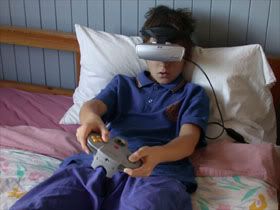
if any of you have read wired recently, you may have noted the article talking about how video games may be key to a steady rise in iq, due to the complex visual nature and problem solving of the performative video game. but now some experts are also saying that gaming helps you adapt to corporate life. beck and wade surveyed 2,500 business professionals and found strong ties between managerial behavior and playing video games. some of the findings of the survey show that gamers are better risk-takers, show confidence in their abilities, place a high value on relationships and employee input, and think in terms of "winning" when pursuing objectives.
also, chip luman from the charles schwab company's call center headquarters in phoenix, says "the people who play games are into technology, can handle more information, can synthesize more complex data, solve operational design problems, lead change and bring organizations through change.''
professor james paul gee of the university of wisconsin-madison recently did a study of a number of popular video games, and found that some of the games with the most cutting-edge teaching principles involved in them, were also some of the most violent ones, games normally displayed with a "mature" rating.
these findings are also counterintuitive to the recent report that emailing, iming and chatting lowers iq. wait - it's better to play video games than communicate over the internet?
even beyond the corporate profile, gaming helps in numerous ways in the hospital workplace. the associated press reported in december that giving a child a gameboy before surgery could relax children more than tranquilizers. also, dr. james rosser, director of the advanced medical technology institute at beth israel medical center, says that in a study it turned out that gamers performed better at surgery. they were less likely to make mistakes during certain forms of operations and suturing.
perfect. now i can skip my homework and play grand theft auto in peace - after all, maybe it's better for me anyway.
source article at mercury news
idea via future now
Posted by
Jim
at
6:28 PM
0
comments
![]()
Wednesday, May 11, 2005
cyborg-ish rhesus macaque monkeys taught to control robotic arm in another room

the arm isn't even in the same room! miguel nicolelis, a mildly mad scientist at the center for neuroengineering has clandestinely slipped some small slivers of electric wire into 2 rhesus macaque monkeys' brains, and recorded the noise. specifically, the wires went directly into the part that controls their arms. the monkeys were taught to interact with cursors on a screen and rewarded for it. the way that they were taught to interact with the screen allowed them to control a robotic arm in the next room, after scientists decoded the noise emitted to the electrodes in their brains. the cool part is that their brain adapted so that they no longer had to move their real arms in order to control the robotic arm, their brain split a section off just for the use of the robotic arm. and they could still use their two other arms independently.
this study shows the brains amazing adaptability, called neuroplasticity, which not only allows our brain to adapt to new habits, thoughts and circumstances, but also to adapt around electrode arrays in our heads, allowing us to distantly control things like mouse cursors on a screen (a paraplegic guy can already play pong through machinic telepathy), robotic arms and much more.
full article at biology news net.
image above by rob camp
Posted by
Jim
at
5:31 PM
0
comments
![]()
self cloning robots
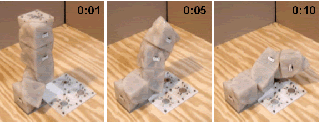
hod lipson and colleagues at cornell university have created the first self-cloning robot (video here). when reading that headline, i originally got really excited - it's not that kind of cloning though, but it's still neat. one robot structure is able to assemble a new robot from transferring information and rotating blocks around, so that a larger structure of these smaller cubes could "clone" itself if it were given a pile of similar robotic cubes to work with - but it can't fabricate these cubes on its own. the robot is composed of identical blocks that can swivel around to connect or disconnect to each other through magnetics, allowing it to construct and deconstruct itself at will. lipson and colleagues are planning on miniaturizing the technology, eventually creating something small enough that it could be really impressive - able to work with itself to build any structure, form legs to walk over obstacles, etc. if these small blocks could somehow communicate with more traditional robot interfaces, you could have the form or body be self-assembling, self changing, while still having the dynamic tools and interfaces of traditional robots, that might be less able to self-form or repair. full article at new scientist
nasa is also working on something similar with the nano-scaled tetwalker, which i wrote about a few weeks ago.
Posted by
Jim
at
4:55 PM
0
comments
![]()
Monday, May 09, 2005
sunny may the month for suicides

researchers at the priory group belief it may be the sunny weather that causes may to be the month with the highest suicide rates. while it is true that sunny days tend to cheer people up, and that people are most depressed during winter, researchers believe that it may be the burst of sunshine in may that makes the month the most popular time to end your life. the sheer amount of warm, fresh, fuzzy sunshine may actually give people the optimism, confidence and energy they need to go through with their suicidal plans. this goes along with the statistical correlation that suicidal tendencies often don't bloom during severe depression, but rather just after it, as the depression is lifting."spring is a time for new beginnings and new life, yet the juxtaposition between a literally blooming world and the barren inner life of the clinically depressed is often too much for them to bear," says professor chris thompson of the priory group
full article at the bbc
Posted by
Jim
at
7:13 PM
1 comments
![]()
where do cars go when they die?

to the auto graveyard.
idea via tacky times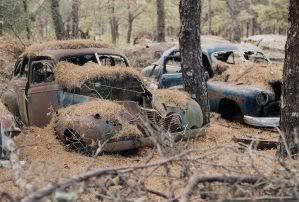

Posted by
Jim
at
4:58 PM
0
comments
![]()
kewpie
 click on images to see videos
click on images to see videos

advertisements for some japanese condiment company
view all videos
idea via we make money not art
Posted by
Jim
at
4:41 PM
0
comments
![]()
new ai based gaming

project nero is a new ai based video game, incorporating some of the most powerful artificial intelligence engines with a state of the art robot battle game. robots advance through use of a "genetic algorithm" allowing autonomous evolution through a sort of reward and punishment system - however the character rates each of the robot's performance in battle. robots are originally trained by the player in a sort of free for all sandbox, before being unleashed in real battle with other players online. the ai allows the robots to evolve on their own, developing their own tactical minds, while also incorporating the styles of the player. the most successful robots will then naturally develop from the players with the most advanced tactical style. the game is currently in the late phases of development and a public version is due to release in the near future.
idea via we make money not art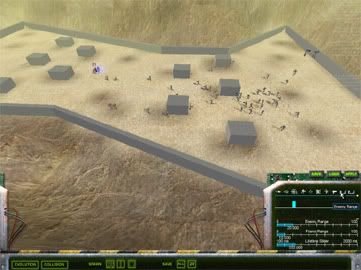
Posted by
Jim
at
3:52 PM
0
comments
![]()
Saturday, May 07, 2005
more gattaca: flatworm genetics hold potential key to limb regeneration

scientists at the university of utah have completed a survey of gene function in a highly regenerative species of worm (flatworms) that could one day lead insight into manipulating cellular regrowth in humans. flatworms have the ability to fully regenerate the rest of their body from a piece as small as 1/279 the size of the whole worm. after mapping out some of the key regenerative genes, scientists found that there are some parallel genes in humans that could one day be manipulated, though sánchez alvarado warns, "it would not be appropriate to speculate on regeneration of human tissue with our current understanding."
full article at wired news
Posted by
Jim
at
8:31 PM
0
comments
![]()
9 democrats forced out of n.c. church for voting kerry

pastor chan chandler led the charge to kick out 9 democrat members of the east waynesville baptist church this saturday, after a warning that anyone voting for kerry during the last presidential election needed to leave the church. a few other church members left willingly in protest, and pastor robert prince III of a nearby first baptist church called the decision "very disturbing."
this reinforces my general outlook towards american politics as a generalized feeling of carefully repressed panic.
full article by the associated press at wired news
Posted by
Jim
at
8:10 PM
0
comments
![]()
Friday, May 06, 2005
chinese carved watermelons

gallery of chinese carved watermelons. brilliant.
idea via boing boing

Posted by
Jim
at
5:18 PM
0
comments
![]()
new study suggests parents neglect ugly children
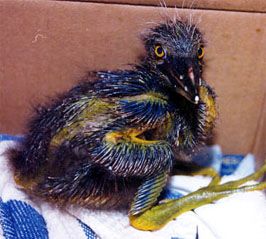
a new study by a team at the university of alberta suggests that parents unconsciously neglect unattractive children. the team followed 426 parents with their children through a supermarket for 10 minute periods (isn't that kind of creepy?), and they recorded how often the child was buckled into the trolley, and also how often the child wandered off more than 10 feet from their parents. the children were rated on a 10 point scale of attactiveness. they found that only 1.2% of the less attractive children were buckled in, compared with 13.3% of the most attractive.
most people were "upset that attractiveness would be a factor - they certainly don't think it is." when you give parents a questionaire, of course they say that they love their children equally, but the harsh reality is much different. if you're socially unattractive, your parents are more likely to value you less, and you're more likely to die, get kidnapped, get abducted by aliens, develop self-esteem issues, etc. the scientists of course consider it a darwinian thing, and not a social difference, which i don't think is exactly clear. this implies that attractiveness is objective and linked directly to health, transcending social trends, which isn't necessarily true.
dr nick barlow of the british psychological society, notes "this is a dangerous report because people talk about designer babies. if we're not careful, scientists will be looking out genes for high cheekbones or blue eyes." and what movie is this just like? gattaca. just like every other genetics article these days.
full article at bbc news
Posted by
Jim
at
4:40 PM
3
comments
![]()
Thursday, May 05, 2005
mice have cells, people have cells, and we all might be able to live 20% longer

whenever cancer comes up in a conversation with my friends, they always say - whatever, they'll have that shit cured by the time i'm old. well, i never thought that was something good to bank on. it's better to just quit smoking or whatever if you want to live longer, right? well, the more i blog, the more i become a technological optimist. maybe science will have everything cured after a while, especially with genetics and all that.
look at this cute mouse. it's ridiculously cute, right? well, it has nothing to do with this article. it's just a cute mouse, and i like to put cute pictures of animals in my entries. but some mice perhaps very much like this one have a new 20% longer life span thanks to the wonders of science.
scientists at the university of washington have found a new way to eliminate free radicals. now, free radicals aren't just political prisoners that have escaped from jail, apparently they're also things that make us die faster, and they live in our bodies. catalase is a chemical in our cells that fights off these evil radicals, but usually it just swims around in our weak weak cytoplasm where it doesn't do all the radical fighting that it could. it's much better when catalase is amped up within the mitochondria, "the powerhouses of the cells." these transgenetic half-immortal super mice lived 20% longer because of this small adjustment, increasing catalase in their mitochondria.
“but it is important to remember that, just as mice are more complicated than flies or nematodes, humans are more complicated than mice."
too true. so, maybe we won't be half-immortal like these cute mice, but these scientists are holding out hope. after all, mice have cells, humans have cells, we all have mitochondria and we all die (if mice ever stole all of our research on them, they'd be all set. seriously). lead scientist on the project (why do scientists always have to pick leaders?) peter rabinovitch, coolly says that while he doesn't expect humans to be genetically altered like the mice, we could make pills able to increase the catalase inside of our mitochondria, having a similar effect as that had on the transgenic mice.
full article at new scientist
Posted by
Jim
at
7:44 PM
0
comments
![]()

